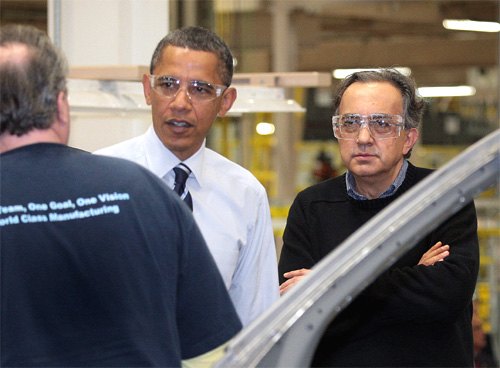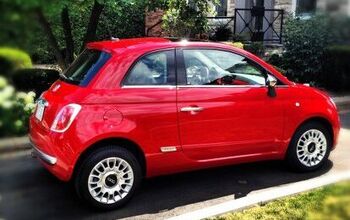Fiat's 40 MPG Fiction
Yesterday’s release of the Congressional Oversight Panel report on the auto bailout pointed out several fundamental problems with the government’s intervention in the auto industry, all of which stem from what the report termed the “mutually exclusive” goals of the Treasury in overseeing its investment in the industry. But that report focused entirely on the post-bailout management decisions by Treasury, ignoring the decisions made during the bailout itself. And though the White House has, in recent months, redefined its goals in bailing out GM and Chrysler to focus on the improved financial performance of the bailed-out automakers, this is clearly a recent recalibration of its political message. As I pointed out in my latest New York Time Op-Ed,
what Mr. Obama called his “one goal” — having Detroit “lead the world in building the next generation of clean cars” — is nowhere near being achieved.
And, as it turns out, the Administration’s actions in the bailout will inevitably come up well short of that goal in at least one important respect.
When the White House’s Automotive Task Force bailed out Chrysler by forming an alliance between the struggling US automaker and the Italian industrial concern Fiat SpA, it gave Fiat some 20 percent of Chrysler’s equity. Fiat also received the right to another 15 percent of Chrysler’s equity in three five-percent chunks, each contingent upon the completion of three government-negotiated commitments. First, it required Fiat to begin commercial production of engines based on its Fully Integrated Robotised Engine family technology in the United States, a goal that was achieved earlier this week. The second commitment requires Chrysler to record $1.5b in revenue from outside the NAFTA zone, as well as Fiat’s
execution… of one or more franchise agreements covering in the aggregate at least ninety percent (90%) o f the total Fiat Group Automobiles S.p.A. dealers in Latin America pursuant to which such dealers will carry [Chrysler] products.
The final commitment of the Fiat-Chrysler alliance has been widely reported in the mainstream media using the language of the White House’s press release, which describes the commitment as
introducing a vehicle produced at a Chrysler factory in the U.S. that performs at 40 mpg
But nowhere in the mainstream media has it been reported whether that 40 MPG number refers to a city, highway or combined rating or whether it refers to an “adjusted” (i.e. what consumers read on the window sticker) or “unadjusted”EPA number. Having received a number of emails seeking clarification on this point, TTAC was heartened to find a link in a footnote of yesterday’s COP report, which put us in possession of the complete Fiat-Chrysler operating agreement [All 168 pages available in PDF format here]. Here we found what the “real reporters” never bothered to dig up: Fiat’s so-called “Irrevocable Ecological Commitment.”
This “commitment” is enshrined in the following “annex” to Fiat and Chrysler’s government-negotiated operating agreement, and reads as follows:
The addendum, as written, seems to be promising: after all, 40MPG combined is far better than, say, 40 MPG highway. But what the “Irrevocable Ecological Commitment” doesn’t specify is what test the government requires for compliance: adjusted EPA, or unadjusted EPA. For this crucial bit of information a little more digging was necessary. Way down, buried in the “definitions” section of the agreement, we finally get our answer:
Here is the dirty truth that neither the government, Fiat, Chrysler, nor the mainstream media has ever bothered to tell the American people: the “green car” that the White House secured US production of will get 40 MPG combined, but that number is to be measured by the “old” (pre-2008), “unadjusted” EPA methodology, which significantly inflates a cars mileage over the number consumers read on an EPA window sticker.
Now that we know the actual criteria for Fiat’s accomplishment of this commitment, the question becomes: did the government secure “the next generation of clean cars” as President Obama promised? The answer seems to be a fairly resounding “no.”At best, the government barely managed to negotiate a commitment to secure production of a vehicle with efficiency equivalent to the “current generation of clean cars.”
40 MPG combined unadjusted translates to almost exactly 30 MPG combined on the “adjusted” EPA test cycle which is used to produce window stickers for vehicles currently on the market. This is hardly a benchmark for a meaningful “Ecological Commitment” in the sense that a significant number of currently-available mass-market cars currently achieve this standard, and the cleanest vehicles on the market exceed it by dramatic amounts. According to the EPA, at least 11 2010 model-year “compact cars” currently achieve the 30 MPG combined adjusted standard. At least six “midsize sedans” achieved the magic number for the outgoing model-year, as did two “upscale sedans,” two convertibles, two station wagons and three SUVs (although the SUVs are all derivatives of the Ford Escape Hybrid).
The most efficient vehicles on the US market also achieve considerably more than 40 MPG on the unadjusted EPA test cycle; for example, the Toyota Prius scores about 70 MPG on the “unadjusted cycle” and the Ford Fusion Hybrid scores around 54 MPG unadjusted. Clearly, the standard for “the next generation of clean cars” should be considerably higher than 40 MPG combined unadjusted.
After all, five percent of Chrysler’s equity, the price taxpayers have paid for this uninspiring “Ecological Commitment,” would be worth quite a bit of money to Fiat if Chrysler’s IPO goes as planned. UBS analysts place a post-IPO valuation estimate on Chrysler of between $11.8b and $27.5b, which means Fiat’s reward for building this car could range from $590m to $1.35b. That’s at least half a billion dollars of taxpayer value going to a foreign automaker for building a car that performs at a level attained by such vehicles as the 2010 Kia Forte, Toyota Corolla and Chevrolet Aveo. And, if the Chrysler insider site Allpar has the correct information, the base model of the “40MPG” car will probably achieve even less-inspiring numbers with its Chrysler “world gas engine.” Consumers will likely have to pay extra for “40 MPG” models using Fiat’s 1.4 liter MultiAir engine.
In his insider account of the auto bailout, Task Force member Steve Rattner writes that the government “struggled” to get Fiat CEO Sergio Marchionne to put up cash for his desired 35% stake in a bailed-out Chrysler, and that the attempt eventually failed. Rattner writes
Eventually, after hard bargaining, Ron [Bloom] succeeded in carving back Fiat’s initial ownership stake to 20 percent, requiring the company to meet meaningful milestones before receiving additional shares…
It’s not clear from Rattner’s account where the 40 MPG “meaningful milestone” came from, but he does relay one anecdote from the Oval Office meeting in which it was narrowly decided to rescue Chrysler which seems instructive:
The President rested his chin on his hands for a few seconds. Then he looked up and said, “I’ve made my decision. I’m prepared to give Chrysler thirty days to see if we can get the Fiat alliance done on terms that make sense to us.” He turned to me and Ron and added, “I want you to be tough and I want you to be commercial.” We took that to mean that we should insist that all our conditions be met in a way that was prudent from the taxpayer’s standpoint.
Not wanting the Chrysler discussion to end on such a down note, [National Economic Council member Brian] Deese -who is anything but shy- piped up from the couch. “I think it’s worth recognizing that there are positive attributes associated with the Chrysler deal if it gets done,” he said. “It’s not all negative, including the fact that while Fiat hasn’t committed money, they have committed themselves with their technology, including a commitment to build a forty-mile-per-hour car in the United States.” People began to laugh, and it took a couple of beats for Deese to realize what he’d said and started laughing along. Building a forty-mile-per-gallon car would indeed be significant — but a forty-mile-per-hour car probably wouldn’t improve Chrysler’s prospects very much.
The sad irony is that, as negotiated by the auto team, Chrysler’s forty-mile-per-gallon car won’t be anywhere near as “significant” as they thought. Just as Deese made a slip of the tongue, task force negotiators made the oldest efficiency calculation mistake in the book: confusing adjusted with unadjusted EPA MPG. Unfortunately, this time nobody will be laughing… except perhaps Fiat CEO Sergio Marchionne.
More by Edward Niedermeyer
Latest Car Reviews
Read moreLatest Product Reviews
Read moreRecent Comments
- Corey Lewis It's not competitive against others in the class, as my review discussed. https://www.thetruthaboutcars.com/cars/chevrolet/rental-review-the-2023-chevrolet-malibu-last-domestic-midsize-standing-44502760
- Turbo Is Black Magic My wife had one of these back in 06, did a ton of work to it… supercharger, full exhaust, full suspension.. it was a blast to drive even though it was still hilariously slow. Great for drive in nights, open the hatch fold the seats flat and just relax.Also this thing is a great example of how far we have come in crash safety even since just 2005… go look at these old crash tests now and I cringe at what a modern electric tank would do to this thing.
- MaintenanceCosts Whenever the topic of the xB comes up…Me: "The style is fun. The combination of the box shape and the aggressive detailing is very JDM."Wife: "Those are ghetto."Me: "They're smaller than a Corolla outside and have the space of a RAV4 inside."Wife: "Those are ghetto."Me: "They're kind of fun to drive with a stick."Wife: "Those are ghetto."It's one of a few cars (including its fellow box, the Ford Flex) on which we will just never see eye to eye.
- Oberkanone The alternative is a more expensive SUV. Yes, it will be missed.
- Ajla I did like this one.




































Comments
Join the conversation
Ed methodically and professionally presented evidence that the critical 40mpg claim was misleading. It was textbook good reporting and factually dispassionate. And some here call it 'frothing', right wing and profit-motivated. Another example of people who would stamp the decree 'hate', 'vitriolic' and 'hurtful tone' on text/speech that is counter to their own views before incinerating the condemned verbiage in the Fairness Furnace.
Big deal, you aren't reporting anything we all don't know already. I have many freinds who bought Fiat 500 Primas and they are consistently reporting getting about 42 MPG but the sticker says 37 MPG. The EPA revises the raw data downward to reflect "real driving conditions", which is that they assume all new cars are bought by teenage hoons who drive around with their foot to the floor all the time. Ford advertises the Feista gets 40 MPG but this only applies to the six speed automatic, the stick gets 37. All car companies dink around with these numbers but the CAFE standards are calcualted with the lab numbers and the Chrysler will get 40 MPG on this test.